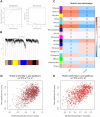Machine learning combining external validation to explore the immunopathogenesis of diabetic foot ulcer and predict therapeutic drugs
- PMID: 40749079
- PMCID: PMC12316216
- DOI: 10.1371/journal.pone.0328906
Machine learning combining external validation to explore the immunopathogenesis of diabetic foot ulcer and predict therapeutic drugs
Abstract
Diabetic foot ulcer (DFU) is a severe complication of diabetes, often leading to amputation due to poor wound healing and infection. The immune-related pathogenesis of DFU remains unclear, and therapeutic drugs are limited. This study aimed to explore the immune mechanisms of DFU and identify potential therapeutic drugs using machine learning and single-cell approaches. Through differential expression analysis of Gene Expression Omnibus (GEO) datasets, we identified 287 differentially expressed genes (DEGs), which were significantly enriched in IL-17 signaling and neutrophil chemotaxis pathways. Weighted gene co-expression network analysis (WGCNA) further pinpointed disease-associated modules containing 1,693 regulatory genes. Machine learning algorithms prioritized seven core genes-CCL20, CXCL13, FGFR2, FGFR3, PI3, PLA2G2A, and S100A8-with validation in an external dataset GSE147890 and single-cell sequencing revealing their predominant expression in neutrophils and keratinocytes. Immune infiltration analysis demonstrated significant dysregulation in DFU patients, characterized by elevated proportions of memory B cells, M0 macrophages, activated mast cells, and neutrophils. Potential therapeutic compounds were identified using the Connectivity Map database and tested through molecular docking and dynamics simulations. The study pinpointed selegiline, L-BSO, flunisolide, PP-30, and fluocinolone as promising therapeutic agents, offering new insights into the pathogenesis of diabetic foot ulcers (DFU) and potential therapeutic strategies.
Copyright: © 2025 Lu et al. This is an open access article distributed under the terms of the Creative Commons Attribution License, which permits unrestricted use, distribution, and reproduction in any medium, provided the original author and source are credited.
Conflict of interest statement
The authors declare no competing interests.
Figures












Similar articles
-
FGFR2 identified as a NETs-associated biomarker and therapeutic target in diabetic foot ulcers.Eur J Med Res. 2025 Aug 13;30(1):748. doi: 10.1186/s40001-025-03012-5. Eur J Med Res. 2025. PMID: 40796870 Free PMC article.
-
Deciphering Shared Gene Signatures and Immune Infiltration Characteristics Between Gestational Diabetes Mellitus and Preeclampsia by Integrated Bioinformatics Analysis and Machine Learning.Reprod Sci. 2025 Jun;32(6):1886-1904. doi: 10.1007/s43032-025-01847-1. Epub 2025 May 15. Reprod Sci. 2025. PMID: 40374866
-
Revealing the Multi-Target Mechanisms of Fespixon Cream in Diabetic Foot Ulcer Healing: Integrated Network Pharmacology, Molecular Docking, and Clinical RT-qPCR Validation.Curr Issues Mol Biol. 2025 Jun 25;47(7):485. doi: 10.3390/cimb47070485. Curr Issues Mol Biol. 2025. PMID: 40728954 Free PMC article.
-
Psychological interventions for treating foot ulcers, and preventing their recurrence, in people with diabetes.Cochrane Database Syst Rev. 2021 Feb 8;2(2):CD012835. doi: 10.1002/14651858.CD012835.pub2. Cochrane Database Syst Rev. 2021. PMID: 35653236 Free PMC article.
-
Platelet-rich plasma for the treatment of diabetic foot ulcer: a systematic review.Front Endocrinol (Lausanne). 2023 Nov 18;14:1256081. doi: 10.3389/fendo.2023.1256081. eCollection 2023. Front Endocrinol (Lausanne). 2023. PMID: 38169990 Free PMC article.
References
-
- Margolis DJ, Malay DS, Hoffstad OJ, Leonard CE, MaCurdy T, De Nava KL, et al. Incidence of diabetic foot ulcer and lower extremity amputation among medicare beneficiaries, 2006 to 2008: Data points# 2. Data points. 2011;2:4. - PubMed
-
- Forde H, Wrigley S, O’Murchadha LT, Cusack L, Casserly S, Moneley D. Five-year outcomes of patients attending a diabetic foot clinic in a tertiary referral centre. Irish Journal of Medical Science (1971-). 2020;189:511–5. - PubMed
MeSH terms
LinkOut - more resources
Full Text Sources
Medical
Miscellaneous

